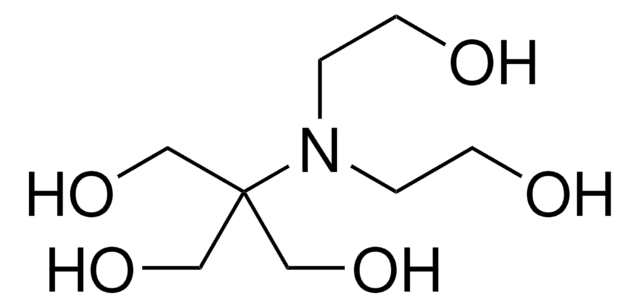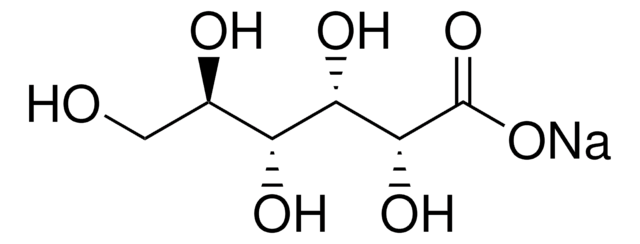Wichtige Dokumente
T9784
Tricin
BioXtra, pH 4.0-6.0 (1 M in H2O), ≥99% (titration)
Synonym(e):
N-[Tris-(hydroxymethyl)-methyl]-glycin
About This Item
Empfohlene Produkte
Produktlinie
BioXtra
Qualitätsniveau
Assay
≥99% (titration)
Form
powder
Verunreinigungen
≤0.005% Phosphorus (P)
≤0.1% Insoluble matter
Glührückstand
≤0.1%
pH-Wert
4.0-6.0 (1 M in H2O)
Nützlicher pH-Bereich
7.4-8.8
pKa (25 °C)
8.1
Löslichkeit
H2O: 1 M, clear, colorless
Anionenspuren
chloride (Cl-): ≤0.1%
sulfate (SO42-): ≤0.05%
Kationenspuren
Al: ≤0.0005%
Ca: ≤0.0005%
Cu: ≤0.0005%
Fe: ≤0.0005%
K: ≤0.005%
Mg: ≤0.0005%
NH4+: ≤0.05%
Na: ≤0.005%
Pb: ≤0.001%
Zn: ≤0.0005%
Absorption
≤0.05 at 280 in H2O at 1 M
≤0.1 at 260 in H2O at 1 M
Anwendung(en)
diagnostic assay manufacturing
SMILES String
OCC(CO)(CO)NCC(O)=O
InChI
1S/C6H13NO5/c8-2-6(3-9,4-10)7-1-5(11)12/h7-10H,1-4H2,(H,11,12)
InChIKey
SEQKRHFRPICQDD-UHFFFAOYSA-N
Suchen Sie nach ähnlichen Produkten? Aufrufen Leitfaden zum Produktvergleich
Allgemeine Beschreibung
Anwendung
- in a polymerase chain reaction (PCR) buffer used in the single-cell collection
- as a component of lactotroph feeding medium for culturing lactotrophs
- to prepare luciferase assay reagent for luciferase activity assay in firefly Photonis pyralis and as a component in Triton/glycylglycine lysis buffer
Sie haben nicht das passende Produkt gefunden?
Probieren Sie unser Produkt-Auswahlhilfe. aus.
Lagerklassenschlüssel
13 - Non Combustible Solids
WGK
WGK 3
Flammpunkt (°F)
Not applicable
Flammpunkt (°C)
Not applicable
Persönliche Schutzausrüstung
Eyeshields, Gloves, type N95 (US)
Hier finden Sie alle aktuellen Versionen:
Besitzen Sie dieses Produkt bereits?
In der Dokumentenbibliothek finden Sie die Dokumentation zu den Produkten, die Sie kürzlich erworben haben.
Kunden haben sich ebenfalls angesehen
Unser Team von Wissenschaftlern verfügt über Erfahrung in allen Forschungsbereichen einschließlich Life Science, Materialwissenschaften, chemischer Synthese, Chromatographie, Analytik und vielen mehr..
Setzen Sie sich mit dem technischen Dienst in Verbindung.





